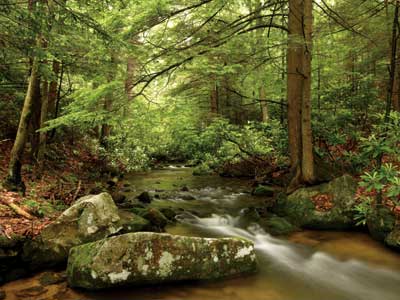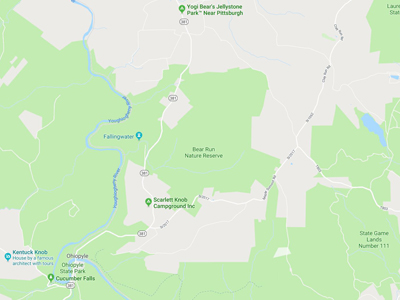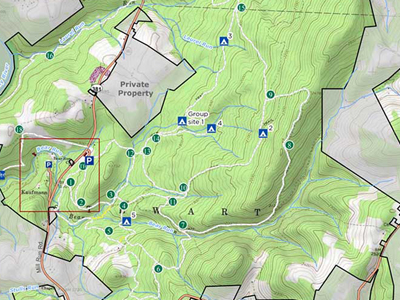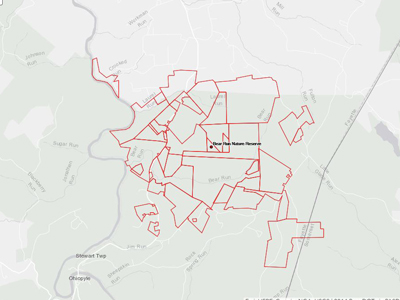A Member's Perspective on COVID-19 and Nature
Matthew F. Muldoon, MD, MPH, a WPC member since 1998, is a professor of epidemiology and psychology at the University of Pittsburgh School of Medicine. In the following essay, “A Virus, Humans and Nature: Ironies Abound,” he shares his perspective about COVID-19 and its correlations to nature and our collective newfound appreciation of the outdoors. The following is Matthew’s piece written after spending time hiking the trails at Bear Run Nature Reserve in Fayette County.
A Virus, Humans and Nature: Ironies Abound
Mother Nature must be in awe of human beings. We homo sapiens are a curious species that invests decades in our young, has scant hair to protect us from the cold, and is neither camouflaged, fierce fighters nor poisonous. And yet, in an evolutionary blink of an eye we have remarkably grown our population and built environment. To this we credit our intelligence and cooperation between individuals. Naturally, we have come to believe that we are masters of this wide world. That hubris has been exposed, and Mother Nature may now hold a wry smile.
 Life on earth exists in ecosystems – remarkable arrays of organisms jostling for advantage in interdependent co-existence. When one species finds success, its very proliferation becomes an opportunity for other members of the biological web. As human beings grow in number and spread, we characteristically reduce and reengineer plant and animal populations to our liking. Natural ecosystems are obliterated where we are most concentrated. Think of shopping centers, industrial complexes and metropolitan hubs.
Life on earth exists in ecosystems – remarkable arrays of organisms jostling for advantage in interdependent co-existence. When one species finds success, its very proliferation becomes an opportunity for other members of the biological web. As human beings grow in number and spread, we characteristically reduce and reengineer plant and animal populations to our liking. Natural ecosystems are obliterated where we are most concentrated. Think of shopping centers, industrial complexes and metropolitan hubs.
Outside our doors man’s reconstruction is widely felt, but Mother Nature has not stood still. In this dramatic instance, she has played what we consider a dirty trick even though it’s as natural as the birds and the bees. A mere virus sprang forth and, for all our intelligence, has us all befuddled and bewildered. We witness sickness and death in every nation and every culture. We argue and lament our suffering.
The pandemic’s fallout has created other striking ironies. Pre-COVID, our spread and material achievements were due to human intelligence but also emerge from our cooperation and reliance on each another. Our societies leverage interpersonal transactions and affiliations to achieve shared aims light-years beyond the capability of any individual. And yet, our many personal contacts and daily travel to interact with distant humans created a petri dish for the virus. We inadvertently welcomed this uninvited guest. Sociality, our great strength, became our great weakness.
We have envisioned the cure as an exquisite vaccine delivered to all peoples of all nations. This complex task leverages our intelligence but requires great effort and time. In the meantime, we have needed a simple strategy – a social intervention – to hold the virus at bay. Observing that our mingling enables virus-jumping we have had no choice but deny him such sweet opportunities. So, social engagements of all sorts have been and remain discouraged, cancelled, or outlawed. While the strategy is modestly effective note how this sly virus not only infects us but provokes us to smother the very catalyst to our many achievements. Highly social communities devolve into asocial individuals. Collaboration is imprisoned, braking our trajectory of success beyond that of the virus itself.
Besides being intelligent and social, we humans are highly emotional. We all vacillate between feeling calm, pleased, irritated, despondent and joyful. These same emotions enrich our relationships, which in turn are our most valued possessions. In our human interactions, we endorse social graces girded by a sympathetic, even warm, view of our fellowman. The antithesis of sympathy is hostility, a bias to view others as competitors or even enemies, evoking envy, derision or worse. Here, too, COVID-19 has intervened.
Normally, a stranger encountered by chance is granted a nod, a smile or even a spoken greeting. Now, physical proximity to almost any human – an outsider, coworker or sister – arouses fear and suspicion. Any smile remains unseen, hidden by masks of self-preservation. Human beings approaching one another avert their eyes and divert their paths, gazing downward and feeling vaguely forlorn. Hostility replaces sympathy. Our antidote creates an anti-social isolation and psychological suffering, further enlarging the plague’s toll.
The COVID-19 virus emerged from nature’s ecosystems to cause unimagined damage, and humans far and wide seek protection and solace. But where? In nature, incredibly. Safety is found away from manmade structures and amid all living things other than humans. Respite, too, abounds in nature. There we go walking, hiking, cycling, skiing, and paddling, using our bodies as designed while breathing unadulterated air. Out of doors, refreshment comes naturally, as do meditation and prayer. Astonishingly, Mother Nature calls us to her bosom despite our transgressions, nurturing and nourishing us. The natural world birthed this anathema, yet it is there that we find healing.
Masters of this wide world? No, we are not. Ambitious if bumbling apprentices? Perhaps, but should we really aspire to mastery? A tiny but potent virus has us all focused on caring for one another – protecting, healing, sharing and soothing. But what of the wider world of bugs, birds and beasts? Might we recast our goal of more and greater human accomplishment to that of caregiving for all the earth’s riches and richness of life?
This horrific pandemic will leave many legacies. We must hope those include a deeper knowledge of human nature, the natural world that surrounds us, and our natural place within it. Human cultures present and long past consider nature our greatest friend and teacher. Perhaps Mother Nature teaches through irony.
Matthew F. Muldoon, MD, MPH
Professor of Epidemiology and Psychology
University of Pittsburgh School of Medicine
Plan Your Visit to Bear Run Nature Reserve
Bear Run Nature Reserve GPS Coordinates: 39.906115, -79.459889
At more than 5,100 acres, exploring Bear Run Nature Reserve can be a true wilderness experience. Many of the trails are rugged and purposely managed to have minimal impact on the surrounding landscape. Be prepared by reviewing reserve information at the trailhead and bringing a GPS unit.
Wear sturdy boots or shoes and have extra water. Also, prepare for your visit by watching this short video about the reserve and reviewing the downloadable maps and materials below. We recommend downloading these files to your mobile device prior to visiting, as cell phone reception is not always available in this area.
Maps of Bear Run Nature Reserve
For More Information:
Western Pennsylvania Conservancy / Fallingwater
P. O. Box R
Mill Run, PA 15464




